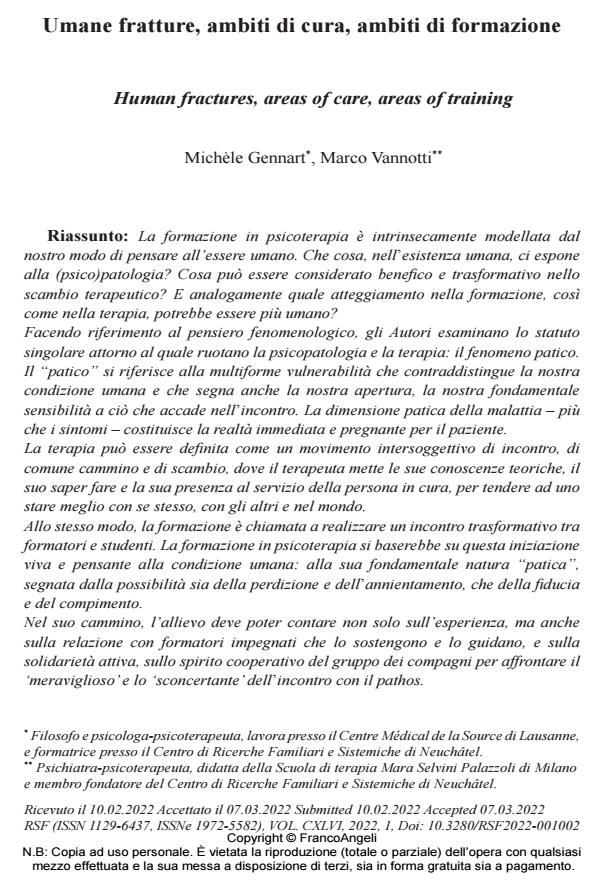Umane fratture, ambiti di cura, ambiti di formazione
Titolo Rivista RIVISTA SPERIMENTALE DI FRENIATRIA
Autori/Curatori Michèle Gennart, Marco Vannotti
Anno di pubblicazione 2022 Fascicolo 2022/1
Lingua Italiano Numero pagine 34 P. 13-46 Dimensione file 240 KB
DOI 10.3280/RSF2022-001002
Il DOI è il codice a barre della proprietà intellettuale: per saperne di più
clicca qui
Qui sotto puoi vedere in anteprima la prima pagina di questo articolo.
Se questo articolo ti interessa, lo puoi acquistare (e scaricare in formato pdf) seguendo le facili indicazioni per acquistare il download credit. Acquista Download Credits per scaricare questo Articolo in formato PDF

FrancoAngeli è membro della Publishers International Linking Association, Inc (PILA)associazione indipendente e non profit per facilitare (attraverso i servizi tecnologici implementati da CrossRef.org) l’accesso degli studiosi ai contenuti digitali nelle pubblicazioni professionali e scientifiche
La formazione in psicoterapia è intrinsecamente modellata dal nostro modo di pensare all’essere umano. Che cosa, nell’esistenza umana, ci espone alla (psico)patologia? Cosa può essere considerato benefico e trasformativo nello scambio terapeutico? E analogamente quale atteggiamento nella formazione, così come nella terapia, potrebbe essere più umano? Facendo riferimento al pensiero fenomenologico, gli Autori esaminano lo statuto singolare attorno al quale ruotano la psicopatologia e la terapia: il fenomeno patico. Il "patico" si riferisce alla multiforme vulnerabilità che contraddistingue la nostra condizione umana e che segna anche la nostra apertura, la nostra fondamentale sensibilità a ciò che accade nell’incontro. La dimensione patica della malattia - più che i sintomi - costituisce la realtà immediata e pregnante per il paziente. La terapia può essere definita come un movimento intersoggettivo di incontro, di comune cammino e di scambio, dove il terapeuta mette le sue conoscenze teoriche, il suo saper fare e la sua presenza al servizio della persona in cura, per tendere ad uno stare meglio con se stesso, con gli altri e nel mondo. Allo stesso modo, la formazione è chiamata a realizzare un incontro trasformativo tra formatori e studenti. La formazione in psicoterapia si baserebbe su questa iniziazione viva e pensante alla condizione umana: alla sua fondamentale natura "patica", segnata dalla possibilità sia della perdizione e dell’annientamento, che della fiducia e del compimento. Nel suo cammino, l’allievo deve poter contare non solo sull’esperienza, ma anche sulla relazione con formatori impegnati che lo sostengono e lo guidano, e sulla solidarietà attiva, sullo spirito cooperativo del gruppo dei compagni per affrontare il ‘meraviglioso’ e lo ‘sconcertante’ dell’incontro con il pathos.
Parole chiave:formazione, psicoterapia, psicopatologia, esperienza patica, vulnerabilità.
Michèle Gennart, Marco Vannotti, Umane fratture, ambiti di cura, ambiti di formazione in "RIVISTA SPERIMENTALE DI FRENIATRIA" 1/2022, pp 13-46, DOI: 10.3280/RSF2022-001002